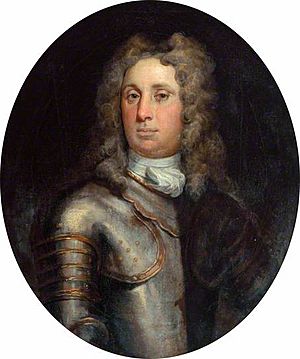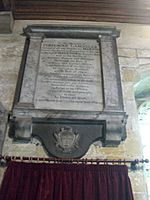Peregrine Lascelles facts for kids
Quick facts for kids
Lieutenant-General Peregrine Lascelles
|
|
|---|---|

Lieutenant-General Peregrine Lascelles, attributed to Sir Godfrey Kneller
|
|
| Born | 1 June 1685 Whitby, Yorkshire |
| Died | 26 March 1772 (aged 86) Whitby, Yorkshire |
| Buried | |
| Allegiance | |
| Years of service | 1706–1754 |
| Rank | Lieutenant-General 1758 |
| Unit | Colonel, 47th Foot |
| Battles/wars | War of the Spanish Succession 1701-1714 Almanara; Saragossa; Villaviciosa 1715 Jacobite rising 1745 Jacobite Rising Prestonpans Father Le Loutre's War Battle of Fort Beauséjour Seven Years' War 1756–1763 Louisbourg Quebec Sainte-Foy |
| Relations | Francis Lascelles (1612-1667) Thomas Lascelles (1670-1751) |
Peregrine Lascelles (1685–1772) was a British military officer from Yorkshire, England. He was a Lieutenant-General, which is a very high rank in the army.
He fought in many important wars. These included the War of the Spanish Succession in Spain and the 1745 Jacobite Rising in Scotland. He also served in North America.
After a long career, he retired in 1768 and passed away in 1772.
Contents
Who Was Peregrine Lascelles?

Peregrine Lascelles was born in 1685 in Whitby, a town in Yorkshire. His family, the Lascelles, lived in different towns across Yorkshire. They were also connected to a wider group of Nonconformist merchants. These were business people who did not follow the main Church of England.
His grandfather, also named Peregrine, and his great-uncles, Francis and Thomas, were involved in the Wars of the Three Kingdoms in the 1600s. Francis even took part in the trial of King Charles I.
Peregrine's father, also Peregrine, owned land near Whitby. His mother, Mary Wigginer, came from a well-known merchant family in Whitby. Peregrine Lascelles himself never married.
His Military Journey
Many of Peregrine's relatives were in the military. This included his cousin, Thomas Lascelles, who became a chief engineer for the army.
Starting His Career (1706-1714)
In April 1706, Peregrine joined the army. He became an officer in a new unit called Lovelace's Regiment. This was during the War of the Spanish Succession. This war was fought to decide who would be the next king of Spain.
In 1708, he moved to Lepell's Regiment of Foot. He was sent to Spain and fought in major battles. These included Almanara, Zaragossa, and Villaviciosa. His unit lost many soldiers in these fights.
After the war, his regiment was disbanded in 1712. Peregrine was put on "half-pay," meaning he received half his usual salary.
Service in Britain (1715-1745)
In 1715, Peregrine became a Captain in Grant's Regiment. This unit was formed to deal with the Jacobite rising. The Jacobites wanted to put a different king on the throne. His unit did not fight in battles but helped keep order. They were stationed at Edinburgh Castle and did policing duties. For his service, he was honored by the city of Glasgow.
Grant's Regiment was disbanded in 1718. By 1723, he was a captain in Churchill's Dragoons. This unit was stationed in different parts of Britain. In 1733, he joined the Guards. This was a special promotion that made him equal to a Lieutenant-Colonel in other regiments.
The 1745 Jacobite Rising
In 1743, Peregrine became a Colonel of the 47th Foot. This regiment helped build a military road in Scotland. This road was finished just before Charles Stuart (also known as Bonnie Prince Charlie) started the 1745 Rising.
At the Battle of Prestonpans on September 21, 1745, the Jacobites quickly defeated the British army. Lascelles managed to escape, but most of his regiment was captured. He faced a court-martial (a military trial) in 1746. He was found innocent, even though the British army lost badly.
North American Service (1750-1763)
In 1750, Lascelles and his regiment were sent to Nova Scotia in North America. There were conflicts between British and French settlers. These clashes were part of Father Le Loutre's War. A major battle was the Battle of Fort Beauséjour in June 1755.
He stayed in North America for part of the Seven Years' War. His 47th Regiment helped James Wolfe capture Louisbourg in 1758. Soon after, he was promoted to Lieutenant-General.
His regiment then fought at the capture of Quebec in 1759, where General Wolfe was killed. They also fought at Sainte-Foy in 1760. The regiment returned to Britain when the war ended in 1763.
Later Life and Legacy

It is not clear exactly when Peregrine Lascelles stopped active duty. He officially left the 47th Regiment in July 1768.
He died on March 26, 1772. He was buried in St Mary's Church, Whitby. His memorial can still be seen there today. A close friend, Doctor John Dealtry, is thought to have written the words on his memorial.



